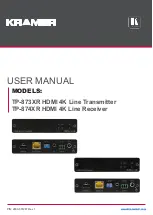
groups. Object Oriented Scanning makes it very easy to delete
or deactivate objects and Scan Lists that you do not want to
listen to, including a powerful temporary lockout mode that allows
you to zero in on activity associated with a specific incident, then
restore your desired configuration when the incident is over.
Finally, Object Oriented Scanning makes it exceedingly easy for
the scannist to enjoy the collection of channels and talkgroups
they have programmed into the scanner, and to share them with
other scannists.
A Few Things To Remember about Object Oriented Scanning
Object oriented scanning is completely different from any prior
scanning receiver technology. Accordingly, some users may find
it difficult to visualize and understand how Object Oriented
Scanning works. This may be especially true for users who have
become very familiar with more recent scanning receiver
technologies.
We suggest that you keep the following “OOUI Tenets” in mind
as you proceed with your study of this manual. If you find
yourself confused or stuck about the basics of Object Oriented
Scanning, it may be helpful to review this section again.
1. The OOUI memory organization is nothing more than a large
list of "Scannable Objects".
2. A "Scannable Object" is simply "something that can be
scanned", including conventional channels, trunking
talkgroups, limit searches, service searches and Spectrum
Sweeper setups.
3. In OOUI scanning, there are no "systems", "banks", "groups",
"sub-groups" or "ID lists". There is simply a very large
collection of objects, each with their own attributes.
Scannable Objects all exist at the same level or hierarchy
within the scanner - no single type of Scannable Object is
more important than another, and Scannable Objects do not
have dependencies on or links to other Scannable Objects in
order for them to function properly.
4. The primary method of grouping the collection of objects is by
mapping them to Scan Lists. Mapping a Scannable Object to
one or more Scan Lists does not change the physical location
of the object in the memory system. Even when an object is
mapped to one or more Scan Lists, the object itself has not
PSR-500 User Manual
Page
15
Summary of Contents for PSR-500
Page 138: ...PSR 500 User Manual V1 9 138...
















































